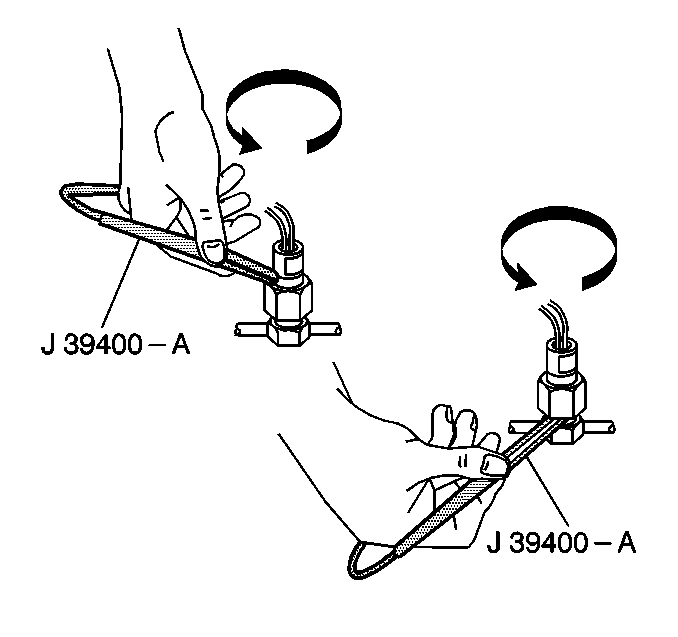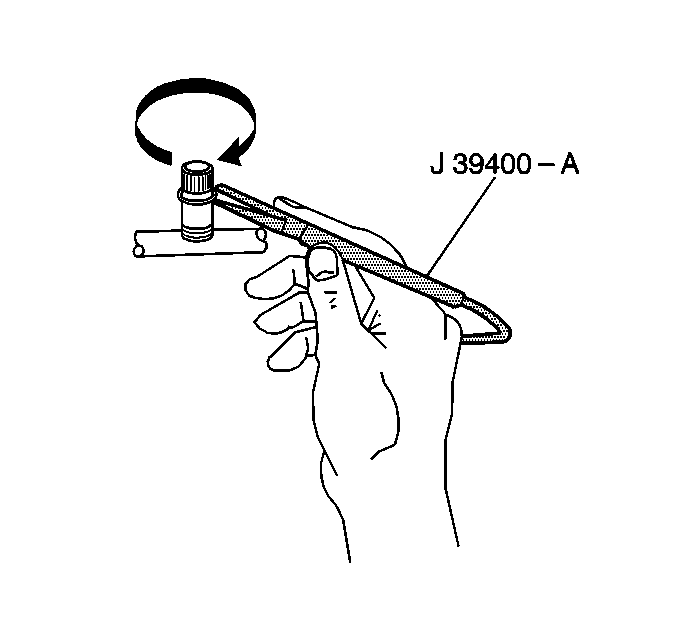Caution: Do not operate the detector in a combustible atmosphere since its sensor
operates at high temperatures or personal injury and/or damage to the equipment
may result.
Perform a refrigerant leak test on the system whenever
you suspect a leak. Also perform a refrigerant leak test after a service
operation which disturbs any of the following items:
Ensure that the vehicle has at least 0.4536 kg (1 lb)
of refrigerant in the refrigeration system in order to perform a leak test.
Electronic Halogen Leak Detector
Tools Required
J 39400 Halogen
Leak Detector.
A halogen leak detector is the most useful tool for locating refrigerant
leaks. The J 39400
is a small unit which operates on 12 V DC. The J 39400
provides an audible signal which
increases in frequency as the unit detects R-134a. Follow the instructions
included with the unit in order to properly calibrate the instrument.
Use the detector in the proper setting for the type of tested refrigerant.
Set the detector gas switch to R-134a prior to use.
The most common leaks occur at the refrigerant fittings or connections.
The leaks may be the result of any of the following conditions:
| • | Lack of lubricant on the O-rings |
| • | Dirt or debris across the O-ring |

| • | Small pieces of lint from
cotton gloves or shop cloths on the O-ring |
In order to successfully use the J 39400
or any other electronic leak detector, maintain a proper
scan rate. Carefully follow the manufacturer's instructions regarding calibration,
operation, and maintenance.
During testing, completely circle each joint using the probe at a rate
of at 51 mm (1-2 in) per second. Place the tip of the
probe less than 6 mm (0.25 in) away from the surface.
Do not block the probe tip air intake. A leak exists when the audible
tone changes from a steady 1-2 clicks per second to a continuous
alarm. Frequently adjust the balance knob in order to maintain the rate
of 1-2 clicks per second.
Important: Halogen leak detectors are sensitive to the following items:
| • | Windshield washing solutions |
| • | Many solvents and cleaners |
| • | Some adhesives used in the vehicle |
Use this procedure in order to test the following components:
| • | The compressor rear head |

Important: Follow a continuous path around the refrigerant system in order to ensure
that you do not miss any possible leaks. In order to ensure that the entire
system is free from leaks, test all of these areas, even after you have
found one leak.
Test the following areas:

| • | The in-line connections |


Fluorescent Leak Detector
Tools Required
Important:
| • | J 41447 is
the only dye approved by General Motors. Not all of the R-134a dyes
are compatible with PAG oil. Some dyes decrease the oil viscosity
or chemically react with the oil. |
| • | PAG oil is water soluble. Condensation may form on the refrigerant
lines or on the evaporator core. This condensation may wash the PAG oil or
the leak dye off of the line or off the core and out through the condensation
drain. Condensation may make some leaks harder to find using the dye
detector. Fluorescence at the drain opening indicates a core leak. |
| • | R-134a tracer dye requires time in order to work. Depending upon
the leak rate, a leak may not become visible for between 15 minutes
and 7 days. |
| • | The dye, when mixed with the PAG oil, remains detectable in the
system for 2 years. Do not double the system using dye. This may cause
reliability problems. Use only the 0.25 oz charge. |
Use a fluorescent leak tracer dye under the following conditions:
| • | If the system has lost a charge |
| • | If the J 39400
does not find the leak |
Fluorescent leak tracer dye mixes with R-134a PAG oil. When you inspect
the leak locations using an ultraviolet light, the dye glows yellow/green.
The dye package contains a refrigerant leak detection notice sticker.
Complete the sticker information. Place the sticker near the charge label.
Dye Injection
Use one of the following methods in order to inject the R-134a dye:
- With the A/C system charged, use the instructions provided with
the new R-134a leak injection tool J 41436-1
.
- With the A/C system discharged, add dye into the new replaced
component assembly.
After servicing an A/C component using dye, clean any residual dye from
the joint and the access port. Cleaning will prevent a false diagnosis later.
Service Ports/Access Valves
The primary seal for the service ports is a sealing cap. The cap contains
an O-ring or a gasket that provides a leak-free seal. The following conditions
will cause a refrigerant loss:
Evaporator Core
One of the most difficult leaks to find is in the evaporator core. Complete
the following steps in order to test the core for leaks:
- Turn the blower on HI for 15 seconds or more.
- Turn the blower OFF.
- Wait 10 minutes.
- Insert the probe in the center A/C outlet.
Compressor Block Fitting and Shaft Seal
- Blow compressed air into the following locations for at least
15 seconds:
| • | Behind the compressor clutch/pulley |
| • | In front of the compressor clutch/pulley |
- Wait 1-2 minutes.
- Probe the area in front of the pulley.
A solid alarm from the detector indicates a leak.





